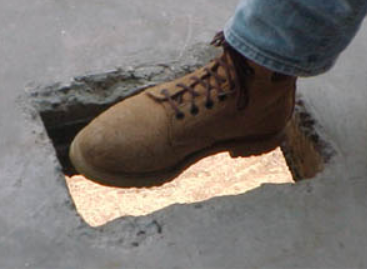Floor openings on a job site can occur during construction, renovations or repairs. There may be floor openings as each new floor in a building is added, for personnel and material access, and for stairwells, elevators or skylights. Floor openings are hazardous because workers may fall through them and/or may be struck by objects that fall through openings. Workers should know about floor openings, guarding, and covers, and understand and use the fall protection appropriate to their worksites and job duties.
One of the first ways to protect against floor opening hazards is to build floors or place temporary flooring below each level of work. This ensures that every worker has a covered floor not more than two stories below his/her worksite. Operations involving erection, riveting, bolting, welding or painting, require flooring directly underneath the work area.
Wood planks or metal decking can serve as protective flooring. Flooring components should be tightly laid together to avoid gaps in which people, tools or materials could fall through. For areas where the flooring cannot reach, wire mesh or plywood may be used to close the gaps. The flooring should be of the proper thickness, grade, and span to carry the working load, assumed to be at least 25 pounds per square foot. The flooring should be tightly secured to avoid displacement by high winds or other forces.
In buildings or structures that can’t accommodate temporary floors, scaffolding or fall protection devices should be used. Safety nets should be installed if scaffolding and fall protection aren’t used, and whenever the potential fall distance is more than two stories or 30 feet.
If construction work in progress requires floor openings to be temporarily uncovered, access to the area should be strictly controlled at all times. The floor area near the floor opening should be barricaded or covered when it’s not attended by authorized personnel doing the work. A qualified person, prior to each shift and after strong wind conditions, should verify the placement of floor opening covers.
All planking and other materials used to cover these temporary floor openings should support 400 pounds or twice the weight of the employees, equipment, and materials that may access one square foot area of the cover at any time. The floor covering should overlap the surrounding structure by 12 inches. It should have a sign that says, “OPENING-DO NOT REMOVE” in 2-inch high, black, bold letters on a yellow background. When working on a job site with floor coverings and floor openings, workers should mind their steps and the floor surfaces their feet will touch.

